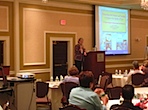As I posted previously, I was honored to present at the Institute for Family Centered Care‘s intensive training seminar, on the leveraging of health information technology to promote patient and family centered care. Bev Johnson, the Institute’s CEO continues to impress me with her boundless energy – I include her in the class of individuals that probably has more energy than I do.
I enjoyed great interaction with the rest of the attendees, many who came in teams, with either a record of change in their institutions, or about to create one. What I haven’t really appreciated to date is the fact that this type of care is still not the norm in most medical institutions. I should say that I appreciate it, but maybe I don’t have the best understanding of the challenges of transforming to a system that involves patients and families in all aspects of care. This includes family presence in all rounds (physician and nursing), 24 hour access to their loved ones in the hospital, ability to access all information generated as part of the care experience. A lot of the seeds of this transformation come from the pediatrics arena; it is slowly making its way into adult health care. There is a significant leadership presence in the nursing community. Imagine a family being present during nursing rounds where a nurse discovers that a scheduled dose of antibiotics has not been given. This seems challenging on its face, but turning it around to create an opportunity for Poka-yoke is far less challenging than allowing an event like this to happen again. I noticed that a lot of nurses and physicians understood this, and it is terrific.
In my own environment, I also reflect on the fact that I’ve been supported in promoting patient-centered health information technology. Yet at the same time, if even a greater percent of the organization’s activities was devoted to promoting this method of care, there are things I might not have to “nemawashi” about that I do now. Regardless, I am happy to do this; if IT is going to be the nidus of patient and family centered care in some organizations, so be it (for now). In the end, though, I’m going to continue to work for IT be the support for patient and family-centered care philosophy, rather than the lever.
Thanks to Bev and the IFCC team for continuing to move into ambulatory care, and to understand the changing landscape of HIT and the opportunities to use it for its true customer, the patient.
